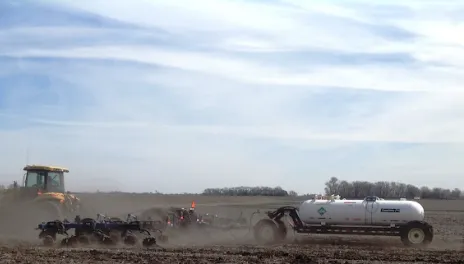Risks and Considerations for Fall Nitrogen Fertilizer Application
As farmers begin to make their decisions on fertilizer management for next spring, considerations for fall application of nitrogen (N) fertilizer should be weighed against the fact that yields are likely to be greater from spring N application than fall application.
Farmers have good reasons why they may fertilize in fall despite the risk of low fertilizer efficiency.
Why farmers apply N fertilizer in fall
- Economic reason – because fertilizer prices are sometimes low in fall
- Short available time in spring for various field operations for large farms
- Risk of a wet spring season, limiting timely field operations
- Logistics - Unavailability of equipment to apply fertilizer at seeding
Risks of N loss from fall application
- High risk of N loss when fertilizer is applied too early in the fall before October or when the soil temperature is still above 50⁰F. Below 50⁰F, microbial activity is slow, and conversion of urea to nitrate (NO3-) which is easily leached below the root zone is slow as well.
- In areas where the risk of fall-applied N loss is relatively low, i.e., where applied N remains largely as ammonium (NH4+-N) that binds and remains on soil surfaces, and winters are dry, N can still be lost in spring when soils are wet and temperatures are above 50⁰F before corn is planted.
Mitigate risks of fall N fertilizer application
To maximize fertilizer efficiency from N fertilization in fall, factors to consider include the form of fertilizer, soil type, soil condition (too wet or too dry?).
- Soil temperature should be less than 50⁰F for at least a couple of days when anhydrous ammonia (NH3) fertilizer is the source of N to be applied, and at least a week for banded urea, and two weeks for broadcast urea.
- Anhydrous NH3 fertilizer is generally more effective than urea because, when applied under the right soil condition (not too dry or wet), some gas escapes from the point of application and kills soil microbes including nitrifying bacteria that convert ammonium to nitrate-N.
- With adequate soil moisture, NH3 will react with water to form ammonium (NH4+), which binds onto the surfaces of soil organic matter and clay.
- Anhydrous ammonia treated with a nitrification inhibitor (Nitrapyrin or N-ServeTM) is recommended as this is effective at preventing N loss, by delaying conversion of ammonium-N to nitrate-N, especially when the soil is wet.
- If using urea, it should be banded no sooner than one week after soil hits 50⁰F
- Urea treated with nitrification inhibitors like SuperU, can also be broadcasted and incorporated when soil is at least 50⁰F for over a week.
- Avoid fall N fertilizer application on sandy soils or soils that drain excessively. These types of soils are more suitable for split-N and side-dress N application in spring
- Avoid N application on wet soils
- Make sure to test the soil to determine how much fertilizer is needed.
- Rather than applying all the N in fall, consider low rates and then side-dress the remainder in the spring.
- UAN is not recommended because, as a liquid N fertilizer, it contains about 25% nitrate nitrogen, which is more vulnerable to loss.
More can be read about fall N guidelines by Dr. D. Franzen at the following website: https://www.ndsu.edu/agriculture/ag-hub/ag-topics/crop-production/crop-pest-report/soils/guidelines-fall-n-application-north-dakota
NDSU does not endorse commercial products or companies even though reference may be made to tradenames, trademarks or service names.
Jasper Teboh, Ph. D.
Jasper.Teboh@ndsu.edu
Soil Scientist
